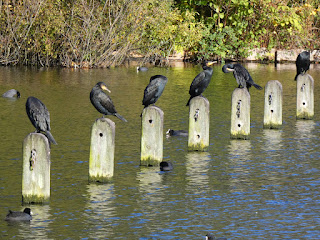Recent strong winds have stripped some of the trees almost bare already. A Jackdaw looked at the last leaves on a sapling ...
... and Starlings gathered in a denuded treetop.
A Robin in the Rose Garden shifted uneasily as people walked by, and finally flew into cover.
A Magpie looked out of a holly tree by the bridge.
The single Common Gull at Peter Pan has been here for more than a week, and still no others have arrived.
Cormorants continue to fly in, and they were all round the Long Water. Soon they will be hunting in packs, an entertaining sight (though the fish find it no fun at all).
Like gulls, they enjoy knocking lower-ranking birds off their perches.
The displaced Cormorant annoyed the victor by simply jumping on to the next post.
A Great Crested Grebe on the Serpentine was already completely in plain winter plumage. You can see that this is an adult because the dark mark on a juvenile's neck would be more vertical, the remains of a stripe.
Greylag Geese got more and more nervous as they saw a loose dog running around, and took off -- not a moment too soon for the last to fly.
The elderly rabbit near the Henry Moore sculpture made the most of the sunshine on a chilly day.
The Shire horses who worked the old mowing machine to cut the grass on Buck Hill were pulling the cart carrying it away.
The plumbago in the Rose Garden, though now withered, is still the most popular spot for bees and other insects. There were several Buff-Tailed Bumblebees, both here ...
... and in a patch of lavender.
Yesterday's still unidentified hoverfly was also here. Conehead 54 asked me if I could provide a picture of its face. This is actually quite difficult to get, as they spend most of the time with their back to you poking into flowers, and here is the best picture I could manage. It looks as if the pale face has a dark central stripe.










I wonder how bumblebees and bees are coping with the winds and the cold. I suppose it must be getting frosty already.
ReplyDeleteThe Magpie is looking gorgeous amont the red berries!
Honeybees can survive the winter in the hive, living on stored honey and pollen. Workers may push the drones out to die in the cold. They huddle round the queen to protect her.
DeleteBumblebee queens hibernate in burrows, making glycerol to act as antifreeze. But all their subjects perish. In the spring they work to form a new colony.
Some solitary bees also hibernate.
Could well be E. luniger. The female in this species has a black Y-shape on the frons. Appreciate it's not easy getting a good face shot for the reason you mention.
ReplyDeleteThanks. No sign of it today, as it was cold and only a few hardy Buff-Tailed Bumblebees and Common Wasps were out.
Delete